Central Tibet
16th century
The hands form the shape of a wheel, symbolizing the “turning of the wheel of dharma,” a reference to teaching the Buddha’s doctrine.
Central Tibet
16th century
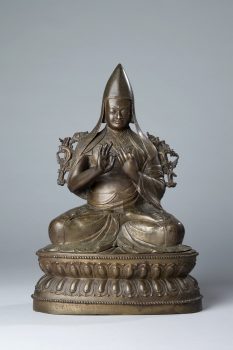
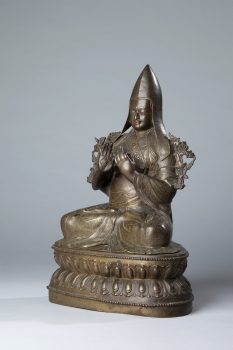
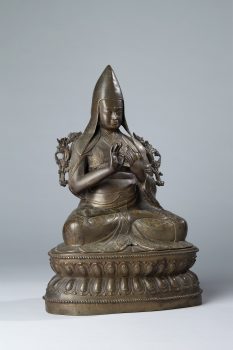
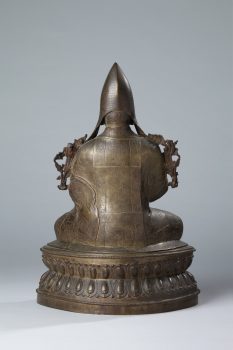
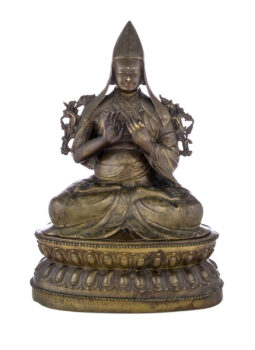
This figure has a finely modeled face with a serene, even contemplative expression, but silver eyes and copper lips add a spark that makes it appear very much alive. The monk is dressed in rich Tibetan monastic garments and wears a pointed hat with long earflaps used in the Sakya and Geluk traditions of Tibetan Buddhism. The details of the monastic dress are executed with great care on both the front and back of this sculpture. Lighter motifs indicating brocade patterns are found on the main garment, while its hem has a thick, finely modeled scroll. This is a bronze sculpture of an important Gelukpa teacher identified as Champa Tashi in the inscription along its base. The teacher is seated in meditation and holds his hands in the gesture of teaching (dharmacakramudra). Once his hands also held the stalks of lotuses of which only fragments to the sides of the upper arms remain. The teacher sits on a double petaled lotus base to which the figure is attached with rivets. The inscription includes wishes that the donor Sanggye Lhaksam Dakpa and all beings may attain awakening and even mentions the artist, Buddhasimha, presumably a Newar from the Kathmandu valley.
A virtuous feeling and deep respect toward an authentic teaching, teacher, or path. Buddhists believe that expansive study, analysis, and meditation are essential steps for cultivating a healthy and enduring devotion.
The passing down of authentic Buddhist teachings from a teacher to a disciple or student, often in the form of a text in a ritualistic context.
The transmission of teachings from one generation to the next, from teacher to student, traced all the way back to the Buddha without interruption. A complete lineage is essential in Tantric Buddhist practices as it makes the blessings of the teaching more powerful.
Himalayan art includes portraits of legendary and historical humans, including accomplished religious teachers (lamas), the Buddha’s original disciples (arhats), and spiritually accomplished tantric masters (mahasiddhas).
Today, Tibetans primarily inhabit the Tibetan Plateau, situated between the Himalayan mountain range and the Indian subcontinent to the west, Chinese cultural regions to the east, and Mongolian cultural regions to the northeast. During the 7th to 9th century, Tibetan rulers expanded their empire across Central Asia, and established Buddhism as the state religion.
Get the latest news and stories from the Rubin, plus occasional information on how to support our work.